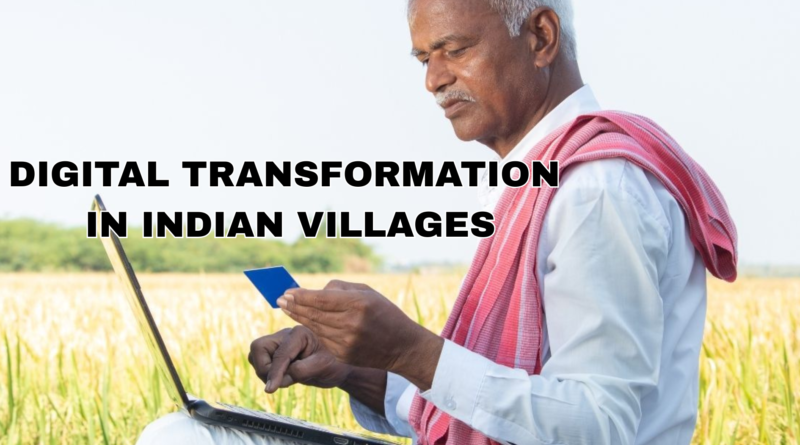DIGITAL TRANSFORMATION IN INDIAN VILLAGES
India is a land of villages. More than 65% of the population still lives in rural areas, depending on agriculture and small-scale industries for their livelihood. For decades, there has been a visible gap between rural and urban India in terms of education, healthcare, employment, and access to technology. But in recent years, digital transformation has started bridging this gap. With the spread of the internet, smartphones, and government initiatives, villages are no longer isolated. They are slowly becoming part of India’s digital growth story.
The Importance of Digital Transformation in Villages
Digital transformation is not just about using the internet. It is about improving the quality of life by using technology in education, healthcare, business, and governance. For villages, this change is very important because:
It connects rural communities with opportunities in cities and across the world.
It provides farmers with updated knowledge about crops, markets, and weather.
It creates new jobs and entrepreneurship opportunities for youth.
It ensures that government schemes reach people without delay.
In simple terms, digital tools give villagers power to improve their lives and reduce dependency on middlemen.
Internet and Mobile Revolution
The spread of affordable mobile phones and cheaper data plans has been the first step in this transformation. A decade ago, internet connectivity was poor in most rural areas. Today, thanks to telecom expansion, villages in states like Uttar Pradesh, Bihar, and Madhya Pradesh are experiencing better coverage.
With the rise of 4G networks and now the entry of 5G, farmers, shopkeepers, students, and women are all able to use smartphones. Villagers are not just consumers of digital content but also creators many are running YouTube channels, small online businesses, and digital services.
Digital Education in Rural India
Education has been one of the biggest beneficiaries of digital transformation. Many children in villages lacked good teachers and resources. Now, through e-learning apps, online classes, and government programs, students can access high-quality study material from anywhere.
Digital classrooms in some government schools, tablets under schemes like Digital India, and online coaching videos have given rural students an equal chance to compete with urban students. Parents are also becoming more aware of the importance of technology in shaping their children’s future.
Digital Healthcare: Reaching the Unreached
Healthcare facilities are limited in rural India. Many villagers have to travel long distances for basic treatment. With telemedicine and mobile health apps, doctors can now provide consultations through video calls.
Government initiatives such as e-Sanjeevani have connected rural patients to doctors in cities. Digital health IDs under the Ayushman Bharat Digital Mission are also helping villagers maintain their medical records online. This not only saves time but also ensures better diagnosis and treatment.
Agriculture and Digital Tools
Since agriculture is the backbone of rural India, digital technology is playing a huge role in modernizing farming. Farmers now receive SMS alerts about weather forecasts, government subsidies, and crop prices. Mobile apps provide guidance on fertilizer use, pest control, and irrigation techniques.
E-commerce platforms are also allowing farmers to sell their produce directly to buyers, reducing the role of middlemen. This ensures better profits and more transparency in the agricultural market.
Digital Payments and Financial Inclusion
Earlier, villagers relied heavily on cash transactions, which often caused problems like fraud, delay, and lack of savings. Now, digital payment apps like UPI, Paytm, and PhonePe are common even in small shops in villages.
Schemes like Jan Dhan Yojana have ensured that almost every household has a bank account. With direct benefit transfer (DBT), subsidies and pensions reach people directly in their accounts. This not only reduces corruption but also encourages savings and financial awareness.
Women Empowerment through Digital Access
One of the most powerful effects of digital transformation has been on rural women. With smartphones and internet access, women are starting small businesses, joining online self-help groups, and learning new skills. Many are selling homemade products through social media and e-commerce platforms.
Digital literacy programs are also training women to handle banking apps, health apps, and digital learning platforms. This empowerment is helping them gain confidence and independence.
Challenges in Digital Transformation
Even though progress is happening, there are still challenges:
Internet connectivity is poor in many remote areas.
Many villagers are not digitally literate and need proper training.
The cost of devices and data is still high for poor families.
Cybersecurity threats and online frauds are rising.
Addressing these issues is important to make digital transformation sustainable and inclusive.
The Road Ahead
Government schemes like Digital India, BharatNet, and rural Wi-Fi hotspots are already working to expand connectivity. NGOs and private companies are also playing a big role in training villagers in digital skills.
The future of rural India depends on how fast and effectively digital tools are adopted. If every village is digitally connected, India’s economic growth will multiply. Rural youth will get better jobs, farmers will earn more, students will learn better, and women will become stronger.




